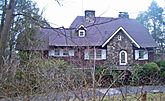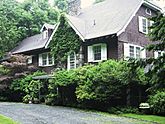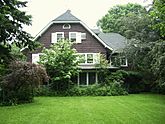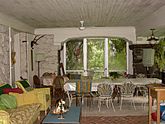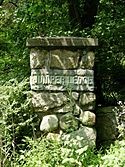Carrie Chapman Catt House facts for kids
Quick facts for kids |
|
|
Carrie Chapman Catt House
|
|

West (front) elevation, 2014
|
|
| Location | 20 Ryder Rd., Briarcliff Manor, New York |
|---|---|
| Area | 4 acres (1.6 ha) |
| Built | 1910 |
| Architectural style | Bungalow/Craftsman |
| NRHP reference No. | 06000336 |
| Added to NRHP | May 4, 2006 |
The Carrie Chapman Catt House, also known as Juniper Ledge, is a special house in New Castle, New York. It was built in the early 1900s in a style called Arts and Crafts. This style focuses on simple designs and natural materials.
In 2006, the house was added to the National Register of Historic Places. This means it's recognized as an important historical site in the United States. A few years later, it also became a local landmark for the town.
The house is a great example of its architectural style. But its main importance comes from being the home of Carrie Chapman Catt from 1919 to 1928. Carrie Catt was a famous leader in the women's suffrage movement. This movement worked to get women the right to vote.
During her time at Juniper Ledge, a huge change happened: the Nineteenth Amendment was passed. This law finally gave women across the U.S. the right to vote! After this, Carrie Catt helped start the League of Women Voters. This group helps people understand elections and encourages them to vote. She also worked to help women get voting rights in other countries.
Carrie Catt found the house a peaceful place to rest. She even started some small-scale farming there, raising chickens and cows. She once joked that she bought the land to stop anyone from using its juniper berries to make gin, which was illegal during the Prohibition time.
After nine years, Carrie Catt and her partner, Mary Hay, moved out. The land around the house has been divided into smaller pieces over time. However, the house itself is still mostly the same as when Catt lived there. It is still a private home today. A composer named Carmino Ravosa learned about Catt's time there and has worked hard to help preserve the house.
Contents
What the House Looks Like
The house is about 4,670 square feet and sits on a 4-acre (1.6 ha) lot. This land slopes down a hill in a wooded area of New Castle. Other houses are nearby, but many trees keep them private. A small stream, which is part of the Pocantico River, flows through the property.
A long driveway leads from Saw Mill River Road to the house. At the entrance, a stone post has "Juniper Ledge" carved into it. The house is near the highest point of the property. Many juniper and cedar trees grow on the land. There's a garage and a swimming pool, but these were added after Carrie Catt lived there.
Outside the House
The house is shaped like a "T" and has two and a half stories. Its bottom part is built with fieldstone, which are natural stones found in fields. The upper part is covered with wood shingles. The roof has a gabled shape (like an upside-down "V") and two stone chimneys. There's a two-story section on the west side and a one-story enclosed porch on the south side, which looks out over the pool.
On the front of the house, there's a stone section that sticks out. A small roof covers the main entrance. Above the entrance, there's a round window with a brick frame.
The other windows on the front of the house are different sizes. They have two panes of glass that slide up and down, and they have wooden shutters. The porch on the south side has large stone supports and is now enclosed with windows. The west side of the house has larger windows, some of which slide open.
Up in the attic area, there's a small window that opens outwards. The roof has wide edges that hang over, and you can see some of the wooden beams (called rafters) that support it. There are also small windows that stick out from the roof, called dormer windows.
Inside the House
When you enter the house through the main front door, you step into a small hallway. From here, you can go to a study, a service area, or the living room. The inside of the house has a Neoclassical style, which means it uses designs inspired by ancient Greek and Roman buildings. For example, the main staircase has a Doric-style newel post (the main post at the bottom of the stairs). The dining room has a fireplace with decorative columns.
The living room is large and has a fireplace in a Colonial Revival style. It also has double doors that lead to the dining room and the south porch. In the service area, there's a kitchen and a former butler's pantry, which is now another small kitchen. Stairs here lead to bedrooms that were once for servants.
On the second floor of the main house, there are four bedrooms and two bathrooms. The attic is partly finished, and the basement is unfinished.
History of Juniper Ledge
Carrie Catt's life before she bought Juniper Ledge helps explain why she chose this particular home. She didn't live there all the time during her nine years, but those years were very important for her work. The house has stayed much the same since she left it.
Carrie Catt's Early Life (1859–1919)
Carrie Lane was born in Wisconsin and grew up on a farm in Iowa. She went to Iowa State University and became a high school principal, then a school superintendent. Her first husband, Leo Chapman, passed away shortly after they married in 1885.
She became very involved in the movement for women's voting rights. When she married her second husband, George Catt, he was a wealthy bridge designer who supported her work. They agreed that she could spend at least four months a year working for women's suffrage. She eventually joined the National American Woman Suffrage Association (NAWSA), the main group fighting for women's right to vote. In 1900, she took over as president from Susan B. Anthony, another famous suffragist.
The Catts lived in New York City. Carrie stepped down from NAWSA's presidency when George became ill in 1904. He died the next year, and Susan B. Anthony died in 1906. George's will left Carrie financially secure. She moved to a nicer apartment and became active in NAWSA again.
In 1915, she returned to NAWSA and was re-elected president. She developed a plan called the "Winning Plan." This plan focused on getting more states to allow women to vote. The goal was to build momentum for a constitutional amendment that would give all women the right to vote in federal elections. By 1917, NAWSA had over two million members. When the U.S. entered World War I, Carrie Catt supported the war effort.
In 1919, she first saw Juniper Ledge. The house was likely built in 1910. At this time, cars were becoming more common, and people were starting to move from cities to suburban areas like northern Westchester County. Old farms were being divided into large lots for people who worked in the city.
Carrie Catt loved Juniper Ledge right away. She wrote that it was "isolated, quiet, restful." She felt it was perfect for "tired nerves" because the land was too steep for serious farming. When she bought it, the property was 13 acres (5.3 ha).
Just before she bought the house, Congress passed the Nineteenth Amendment. This amendment would give women the right to vote. President Woodrow Wilson even sent her a telegram to congratulate her. The amendment still needed to be approved by three-quarters of the states. So, Carrie Catt traveled the country, giving speeches and attending rallies to help get it ratified. During this time, she realized that women would need information and guidance on how to vote and participate in public policy. This led her to found the League of Women Voters (LWV).
Carrie Catt Living at Juniper Ledge (1919–1928)
At Juniper Ledge, Carrie Catt lived with her partner, Mary Garret "Mollie" Hay. Mollie helped take care of the property. Even though Carrie had thought the land wasn't good for farming, they made improvements. They fixed the driveway, worked on the stream, planted gardens, and started raising chickens and cows. Carrie told her biographer, Mary Gray Peck, that the house was "mine for better or worse."
Mary Gray Peck visited the house and was very impressed. She described the "wide lawn, flower borders, terraced hillside, great outcropping rocks, spire-like junipers, forest trees, old apple trees." She said that from the house, you could see "a long and misty valley spread out below."
In August 1920, enough states approved the Nineteenth Amendment, and it became part of the Constitution. Carrie Catt had achieved her main goal. But she wasn't finished. Besides starting the LWV, she began working for women's voting rights around the world. She did this through the International Women's Suffrage Alliance, which she had helped create in 1904. She remained its president until 1923.
The house became a popular meeting place for Carrie Catt's fellow activists. In June 1921, The New York Times reported on a picnic held there. One hundred members of the LWV from New York City welcomed her back from a trip. During her trip, she had received honorary law degrees from her old school, Iowa State University, and the University of Wyoming. She and her guests visited 14 trees on the property. Carrie Catt had placed bronze plaques on these trees to honor important suffragists like Esther Hobart Morris and LWV president Maud Wood Park.
The trees were important to Carrie Catt for another reason too. Like many suffragists, she had supported Prohibition. This was a time when making and selling alcohol was illegal because of the Eighteenth Amendment. Since juniper berries are a main ingredient in gin, she told her guests that she bought the property to make sure those berries would never be used for alcohol.
Her activism continued. She co-wrote a history of the suffrage movement. She also traveled to Europe and South America for the cause. On one trip in 1923, she met Italian dictator Benito Mussolini and spoke to him about women's rights. When Carrie was away, Mollie Hay, who felt lonely at Juniper Ledge, would rent an apartment in New York City.
When she was home, Carrie Catt spent a lot of time on the property. She built a house for her chauffeur and added the west wing to the main house. She also continued to farm and garden. A 1923 article described her "every summer wearing for the most part of the day a wide brimmed hat and summer dress, out among her flowers and vegetables, happy to be back upon the land."
In the mid-1920s, she started working on promoting world peace. In 1925, she founded the Committee for the Cause and Cure of War. In 1926, she was invited to a meeting at the White House that helped solve a disagreement with Mexico and prevented a war.
In the summer of 1927, both Carrie Catt and Mollie Hay had some health problems at Juniper Ledge. Since Mollie never liked country life as much as Carrie did, they decided to sell the house. They wanted to move somewhere they both liked better. They first thought about Arizona or California, but then decided to stay closer to New York City. They bought a cottage near Long Island Sound in New Rochelle. They probably took the bronze plaques from the trees with them. Nine of these plaques were saved by another suffragist, Edna Stantial, and are now part of her papers at Harvard University.
Mollie Hay passed away shortly after they moved. Her death affected Carrie Catt, who suffered from shingles and then a heart attack. She recovered and lived until a second heart attack in 1947. Her activism was more limited in her later years. Carrie Catt and Mollie Hay are buried next to each other in Woodlawn Cemetery in the Bronx.
The House Today (1929–Present)
After Carrie Catt and Mollie Hay moved, the property was divided into smaller pieces. The Taconic State Parkway opened in Westchester County in the early 1930s. This made it easier for people to drive to work in the city. Land values near parkway exits, like Juniper Ledge, went up as more people wanted to live there. Much of Carrie Catt's original land was sold over the years, including the parcel with the chauffeur's house. Eventually, only 4 acres (1.6 ha) of Catt's original land remained with the main house.
The house itself has had several owners. In the early 1950s, Nora and Peter Roots lived there with their children. Later, Walter and May Large owned the house. They were known for being involved in town activities and for their kindness to people in the nearby area of Millwood. May Large even helped start a local women's club.
In the early 2000s, the house's history became known again. Carmino Ravosa, a composer famous for his work on children's TV shows like Captain Kangaroo, was researching a musical. He learned that Carrie Catt had lived in the area. He already knew about her life from another musical he had written. He started working to have the house preserved and recognized as a landmark. He said, "this house may be the most important thing I've done."
His efforts led to the house being listed on state and national registers in 2004. However, the owner then wanted to sell the house. Ravosa worked to find a buyer who would respect its history and keep it in its original form. The only major change to the house had been enclosing the porch, which didn't remove any original parts. In 2011, the New Castle Town Board also recognized it as a local landmark.
Gallery





